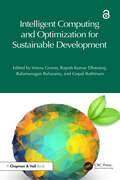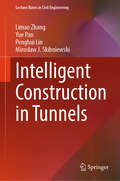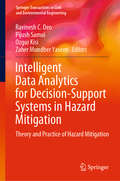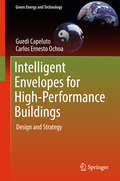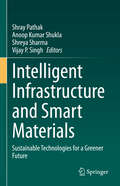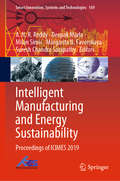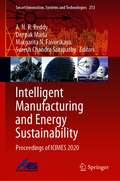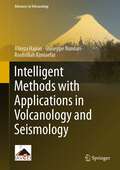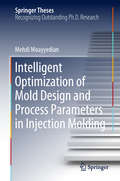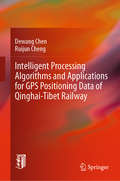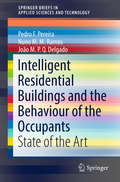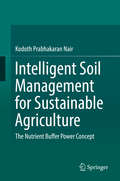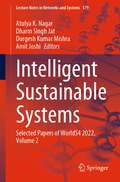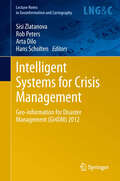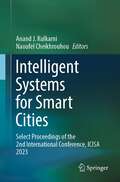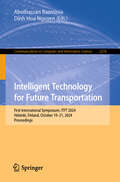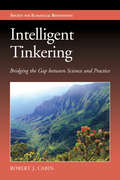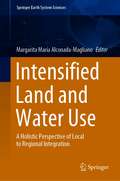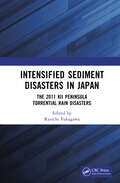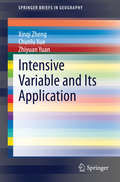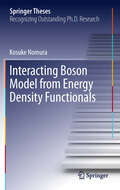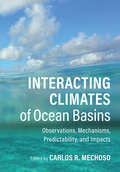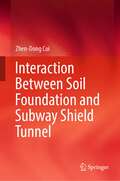- Table View
- List View
Intelligent Computing and Optimization for Sustainable Development
by Balamurugan Balusamy Rajesh Kumar Dhanaraj Veena Grover Gopal RathinamThis book presents insights into how Intelligent Computing and Optimization techniques can be used to attain the goals of Sustainable Development. It provides a comprehensive overview of the latest breakthroughs and recent developments in sustainable, intelligent computing technologies, applications, and optimization techniques across various industries, including business process management, manufacturing, financial sector, agriculture, financial sector, supply chain management, and healthcare. It focuses on computational intelligent techniques and optimization techniques to provide sustainable solutions to many problems. Features: Provides insights into the theory, implementation, and application of computational intelligence techniques in many industries Includes industry practitioner perspectives and case studies for a better understanding of sustainable solutions Highlights the role of intelligent computing and optimization as key technologies in decision-making processes and in providing cutting-edge solutions to real-world problems Addresses the challenges and limitations of computational approaches in sustainability, such as data availability, model uncertainty, and computational complexity, while also discusses emerging opportunities and future directions in the field This book will be useful for professionals and scholars looking for up-to-date research on cutting-edge perspectives in the field of computational intelligent and optimization techniques in the areas of agriculture, industry, financial sector, business automation, renewable energy, optimization, and smart cities.
Intelligent Construction in Tunnels (Lecture Notes in Civil Engineering #679)
by Limao Zhang Yue Pan Mirosław J. Skibniewski Penghui LinThis book highlights the latest technologies and applications of intelligent construction in the domain of tunneling works. Rapid urbanization has surged the rapid development of underground infrastructures in major metropolitans around the world over the past decades. The development of urban tunnel systems is a challenging task with high complexity in terms of design, construction, and maintenance. Recent advancements in information and communication technologies (ICTs) have driven vast transformations around the world with successful implementations in many domains of science. Under the concept of &“industry 4.0&”, there are many attempts at intelligent construction using the latest ICTs, where the major applications in urban system development mainly focus on building information modelling (BIM), Internet of Things (IoT), deep learning, and computer vision. A tremendous transformation has taken place in the past years with the emerging intelligent construction applications in urban tunnel development. This enables industrial participants to operate projects more efficiently and safely, not only increasing the automation and productivity in tunnel development but also enhancing construction competitiveness globally.
Intelligent Data Analytics for Decision-Support Systems in Hazard Mitigation: Theory and Practice of Hazard Mitigation (Springer Transactions in Civil and Environmental Engineering)
by Pijush Samui Ozgur Kisi Ravinesh C. Deo Zaher Mundher YaseenThis book highlights cutting-edge applications of machine learning techniques for disaster management by monitoring, analyzing, and forecasting hydro-meteorological variables. Predictive modelling is a consolidated discipline used to forewarn the possibility of natural hazards. In this book, experts from numerical weather forecast, meteorology, hydrology, engineering, agriculture, economics, and disaster policy-making contribute towards an interdisciplinary framework to construct potent models for hazard risk mitigation. The book will help advance the state of knowledge of artificial intelligence in decision systems to aid disaster management and policy-making. This book can be a useful reference for graduate student, academics, practicing scientists and professionals of disaster management, artificial intelligence, and environmental sciences.
Intelligent Envelopes for High-Performance Buildings
by Guedi Capeluto Carlos Ernesto OchoaThis book presents a series of significant methods and examples for the design of sustainable intelligent facades in a variety of contexts. Emphasis is placed on how intelligence has been applied for successful energy-saving efforts in the planning of building envelopes. Readers will find essential information on the core principles involved in designing, calculating and organizing intelligent facades according to the need for a new or retrofitted building. Not only are different materials and technologies considered, but also efficient ways to combine them according to user needs and other project-specific constraints. Illustrations, tables and graphs accompany the text, clarifying the concepts discussed. Architects, facade consultants and all those interested in and energy-saving measures and improved indoor comfort will find this book useful not only as an introduction to the subject but also as a guide to achieving more responsive building methods.
Intelligent Infrastructure and Smart Materials: Sustainable Technologies for a Greener Future
by Vijay P. Singh Anoop Kumar Shukla Shray Pathak Shreya SharmaThis book delves into the intersection of advanced technologies, sustainable development, and the crucial role of infrastructure in shaping a more environmentally friendly world. In the contemporary era, as societies grapple with the challenges of climate change, resource depletion, and urbanization, the concept of intelligent infrastructure becomes paramount. The book explores how integrating cutting-edge technologies such as artificial intelligence, Internet of Things (IoT), and smart materials into our built environment can contribute to the creation of more efficient, resilient, and sustainable infrastructure systems. The significance of this book lies in its comprehensive exploration of the potential of intelligent infrastructure and smart materials to address pressing environmental issues. It sheds light on how these technologies can optimize energy consumption, reduce waste, and enhance the overall efficiency of infrastructure networks. Moreover, the book emphasizes the importance of sustainability in the context of infrastructure development, urging a shift towards eco-friendly practices. By showcasing real-world examples and case studies, the book provides practical insights into the implementation of intelligent infrastructure solutions, making it a valuable resource for researchers, engineers, policymakers, and anyone interested in the intersection of technology and sustainability.
Intelligent Interpretation for Geological Disasters: From Space-Air-Ground Integration Perspective
by Lizhe Wang Cheng Zhong Weitao Chen Xuwen QinThis book comprehensively utilizes the new generation of artificial intelligence and remote sensing science and technology to systematically carry out researches on high-precision recognition, monitoring, analysis, and assessment of geological disasters by using different technologies of "ground, airspace, and space-based systems" and different scales of "target-semantic-region". The main contents include: 1) Intelligent interpretation theory and methods of geological disasters, 2) Intelligent analysis of landslide based on long-term ground monitoring data, 3) Intelligent analysis of landslide evolution based on optical satellite remote sensing data, 4) Deep learning-based remote sensing detection of landslide, 5) Intelligent assessment methods of landslide susceptibility, 6) Intelligent recognition of ground figure based on airspace-based remote sensing data. The book is of interest to graduate student, scientific, and technological personnel who work in the area of geological disasters, natural hazards, remote sensing, and artificial intelligence.
Intelligent Manufacturing and Energy Sustainability: Proceedings of ICIMES 2019 (Smart Innovation, Systems and Technologies #169)
by Margarita N. Favorskaya Suresh Chandra Satapathy A. N. R. Reddy Deepak Marla Milan SimicThis book includes selected, high-quality papers presented at the International Conference on Intelligent Manufacturing and Energy Sustainability (ICIMES 2019) held at the Department of Mechanical Engineering, Malla Reddy College of Engineering & Technology (MRCET), Maisammaguda, Hyderabad, India, from 21 to 22 June 2019. It covers topics in the areas of automation, manufacturing technology and energy sustainability.
Intelligent Manufacturing and Energy Sustainability: Proceedings of ICIMES 2020 (Smart Innovation, Systems and Technologies #213)
by Margarita N. Favorskaya Suresh Chandra Satapathy A. N. R. Reddy Deepak MarlaThis book includes best selected, high-quality research papers presented at the International Conference on Intelligent Manufacturing and Energy Sustainability (ICIMES 2020) held at the Department of Mechanical Engineering, Malla Reddy College of Engineering & Technology (MRCET), Maisammaguda, Hyderabad, India, during August 21-22, 2020. It covers topics in the areas of automation, manufacturing technology and energy sustainability and also includes original works in the intelligent systems, manufacturing, mechanical, electrical, aeronautical, materials, automobile, bioenergy and energy sustainability.
Intelligent Methods with Applications in Volcanology and Seismology (Advances in Volcanology)
by Giuseppe Nunnari Alireza Hajian Roohollah KimiaefarThis book presents intelligent methods like neural, neuro-fuzzy, machine learning, deep learning and metaheuristic methods and their applications in both volcanology and seismology. The complex system of volcanoes and also earthquakes is a big challenge to identify their behavior using available models, which motivates scientists to apply non-model based methods. As there are lots of seismology and volcanology data sets, i.e., the local and global networks, one solution is using intelligent methods in which data-based algorithms are used.
Intelligent Optimization of Mold Design and Process Parameters in Injection Molding (Springer Theses)
by Mehdi MoayyedianThis book describes an effective framework for setting the right process parameters and new mold design to reduce the current plastic defects in injection molding. It presents a new approach for the optimization of injection molding process via (i) a new mold runner design which leads to 20 percent reduction in scrap rate, 2.5 percent reduction in manufacturing time, and easier ejection of injected part, (ii) a new mold gate design which leads to less plastic defects; and (iii) the introduction of a number of promising alternatives with high moldability indices. Besides presenting important developments of relevance academic research, the book also includes useful information for people working in the injection molding industry, especially in the green manufacturing field.
Intelligent Processing Algorithms and Applications for GPS Positioning Data of Qinghai-Tibet Railway
by Dewang Chen Ruijun ChengTaking the Qinghai–Tibet Railway as an example, this book introduces intelligent processing for Global Positioning Data (GPS) data. Combining theory with practical applications, it provides essential insights into the Chinese Qinghai–Tibet Railway and novel methods of data processing for GPS satellite positioning, making it a valuable resource for all those working with train control systems, train positioning systems, satellite positioning, and intelligent data processing. As satellite positioning guarantees the safe and efficient operation of train control systems, it focuses on how to best process the GPS data collected, including methods for error detection, reduction and information fusion.
Intelligent Residential Buildings and the Behaviour of the Occupants: State of the Art (SpringerBriefs in Applied Sciences and Technology)
by Nuno M.M. Ramos João M.P.Q. Delgado Pedro F. PereiraThis book presents the state of the art of two areas: intelligent residential buildings and the behaviour of their occupants. These areas need to be treated together in order to develop new concepts for buildings, which are more efficient, more comfortable and more healthy. The concept of intelligent building is associated with the creation of a management system that takes into account the requirements of the occupants in terms of thermal comfort and their daily activities, maintaining good indoor air quality and minimizing energy consumption. In commercial or office buildings, these systems are already at an intermediate stage of implementation. However, in the residential sector they have yet to be significantly implemented. In mild climates, where the interactions of the occupants with the building mechanisms are the primary way to ensure adequate comfort and ventilation, the importance of occupant behaviour studies and their incorporation in the algorithms of the intelligent buildings becomes even more crucial. This book offers new concepts on how to bring these aspects together.
Intelligent Soil Management for Sustainable Agriculture: The Nutrient Buffer Power Concept
by Kodoth Prabhakaran NairThis book conceptualizes a revolutionary idea based on a mechanistic-mathematical model in which the “Buffer Power” of the principal and problematic nutrients like phosphorus, potassium and zinc is quantified. This is achieved by using either a very sophisticated technique, electro-ultra-filtration, or a simple adsorption-desorption equilibrium technique, and by integrating the “Buffer Power” of the nutrient in question into the computations, accurate fertilizer recommendations are made. This technique was field tested across Europe, (Germany and Belgium), Africa (The Republic of Cameroon), and Asia (both Central Asia- Turkey and South Asia-India), during a period of three decades in test crops, such as, summer rye (Secale cereale), maize (Zea mays), wheat (Triticum aestivum), white clover (Trifolium repens), a highly nutritious and palatable fodder crop for Africa, black pepper (Piper nigrum) and cardamom (Elettaria cardamomum). Remarkable precision in predictability of plant uptake of phosphorus, potassium and zinc was obtained employing the technique.“The Nutrient Buffer Power Concept” project was shortlisted for the very prestigious U.S. $1 Million Rolex Awards For Enterprise of The Rolex Foundation, Geneva, Switzerland, for its outstanding originality and quality from more than 3500 nominations worldwide and is the only project chosen for this very coveted distinction from the Asian continent.
Intelligent Sustainable Systems: Selected Papers Of Worlds4 2022 (Lecture Notes In Networks And Systems Series #579)
by Amit Joshi Durgesh Kumar Mishra Atulya K. Nagar Dharm Singh JatThis book provides insights of World Conference on Smart Trends in Systems, Security and Sustainability (WS4 2022) which is divided into different sections such as Smart IT Infrastructure for Sustainable Society; Smart Management Prospective for Sustainable Society; Smart Secure Systems for Next Generation Technologies; Smart Trends for Computational Graphics and Image Modeling; and Smart Trends for Biomedical and Health Informatics. The proceedings is presented in two volumes. The book is helpful for active researchers and practitioners in the field.
Intelligent Systems for Crisis Management
by Sisi Zlatanova Arta Dilo Hans Scholten Rob PetersThere have been major advances in technologies to support crisis response in the last few years. However, many aspects related to the efficient collection and integration of geo-information, applied semantics and situation awareness for disaster management are still open. To advance the systems and make them intelligent, an extensive collaboration is required between emergency responders, disaster managers, system designers and researchers. To facilitate this process the Geo-information for Disaster Management (Gi4DM) conference has been organized since 2005. Gi4DM is coordinated by the Joint Board of Geospatial Information Societies (JB GIS) and the ad-hoc Committee on Risk and Disaster Management. This volume presents the results of the Gi4DM 2012 conference, held in Enschede, the Netherlands, on 13-15 December . It contains a selection of around 30 scientific and 25 best-practice peer-reviewed papers. The 2012 Gi4DM focuses on the intelligent use of geo-information, semantics and situation awareness.
Intelligent Systems for Smart Cities: Select Proceedings of the 2nd International Conference, ICISA 2023
by Anand J. Kulkarni Naoufel CheikhrouhouThis book presents the select proceedings of the 2nd International Conference on Intelligent Systems and Applications 2023. The theme of this conference is ‘Intelligent Systems for Smart Cities'. It covers the topics of intelligent systems in multiple aspects such as healthcare, supply chain and logistics, smart homes and smart structures, banking and finance, a sustainable environment, social media and cyber security, crime prevention, and disaster management. The book will be useful for researchers and professionals interested in the broad field of artificial intelligence and machine learning.
Intelligent Technology for Future Transportation: First International Symposium, ITFT 2024, Helsinki, Finland, October 19–21, 2024, Proceedings (Communications in Computer and Information Science #2378)
by Abolhassan Razminia Dinh Hoa NguyenThis book constitutes the refereed proceedings of the First International Symposium on Intelligent Technology for Future Transportation, ITFT 2024, held in Helsinki, Finland, during October 19–21, 2024. The 32 full papers presented in this volume were carefully reviewed and selected from 74 submissions. They are organized according to the following topics: Intelligent Vehicle Technology and Applications; Intelligent Transportation Management and Traffic Flow Analysis; and Intelligent Transportation Infrastructure and Sustainable Transportation.
Intelligent Tinkering: Bridging the Gap between Science and Practice (Science Practice Ecological Restoration)
by Robert J. CabinRobert J. Cabin explores the relationship between science and practice in ecological restoration. Despite the often distinct cultures and methodologies of scientists and practitioners, Cabin shows how each has a vital role in effective restoration and offers suggestions for improving working relationships. One approach he advocates is what he calls "intelligent tinkering," where practitioners employ the same kind of careful but informal trial-and-error strategy followed by such groups as indigenous peoples and hobbyist mechanics. Cabin illustrates the power of intelligent tinkering using examples from his own work and other restoration projects. The gap between science and practice is a widespread problem across all fields of applied science. Intelligent Tinkering offers an insightful look at the underlying causes of the problem, along with invaluable suggestions for addressing it.
Intelligente und nachhaltige Technologie für widerstandsfähige Städte und Gemeinden
by Lakhmi C. Jain Robert J. Howlett John R. Littlewood Marius M. BalasBei diesem Buch handelt es sich um eine Sammlung erweiterter Fassungen von Vorträgen, die auf dem internationalen KES-Gipfel Covid-19 Herausforderung gehalten wurden. Der Schwerpunkt des Buches liegt auf technologischen, wirtschaftlichen und sozialen Entwicklungen zur Bekämpfung der Auswirkungen globaler und lokaler Katastrophen sowie auf der Frage, wie die Erholung von Covid genutzt werden kann, um widerstandsfähigere und nachhaltigere Gemeinschaften und Industrien aufzubauen und die Umwelt zu verbessern. Auch die globalen Herausforderungen des vom Menschen beeinflussten Klimawandels werden erörtert. Die Kapitel befassen sich mit der Stärkung der Widerstandsfähigkeit von Städten und Gemeinden durch Energieautarkie, Lebensmittelproduktion, widerstandsfähige Wohnungen und Gebäude, menschliche Gesundheit und intelligente Systeme, z. B. für Vorhersagen und Prognosen.
Intensified Land and Water Use: A Holistic Perspective of Local to Regional Integration (Springer Earth System Sciences)
by Margarita María Alconada-MaglianoThis book combines multidisciplinary studies on the environmental consequences of intensified use of land and water, and the fusion of land to provide food for a growing population. Studies on water, vegetation, and soil are addressed from an environmental management perspective with a special focus on the relation between natural elements and humans. This book considers the essential dynamics of humans and the natural environment, which is especially important in areas with shallow water-table that influence directly on agricultural activities (crops, livestock, and forests), land management, flooding, droughts, waterlogging, salt-affected soils (saline and sodic) and variation in obtained water quality in wells where these processes as related to the local and regional geomorphology control. The studies present hydrological processes towards the definition of an adequate use of soil and water with consequences of its management on the environment. Also, water study procedures are presented as well as their relation to other elements of the landscape. Methodologies such as the Tóthian flow system concept are recognized by different authors to provide the reader with solid interdisciplinary analyses of related environmental components such as soils, vegetation, surface water, geomorphology, geological framework and groundwater physical-chemical composition.
Intensified Landslide Disasters in Japan: The 2011 Kii Peninsula Torrential Rain Disasters
by Ryoichi FukagawaThe 2011 Kii Peninsula disaster was postwar Japan’s largest sediment and flood disaster. This book analyzes the disaster and the emergency response and subsequent disaster-prevention efforts. It also provides an international comparison and recommendations for mitigation and recovery efforts. Although the scale and intensity of the disaster were expected to occur just once every 100 years, global warming has seen the intensification of such disasters around the globe. This book therefore presents an invaluable in-depth reference for readers on how to prepare for such a disaster, identify risk factors, and react accordingly. Contributors draw on the results of field surveys conducted by the Japanese Geotechnical Society at the time of the disaster and subsequent developments. First, they explain the factors that contributed to the disaster, including the meteorological, topographical, and geological conditions at the time of the disaster. They then describe the mechanisms of slope failure and damage caused by the slope failures across Nara, Wakayama, and Mie prefectures. Finally, they describe the post-disaster response, including the recovery and reconstruction and disaster-prevention and mitigation efforts in the affected area. Readers will therefore understand the importance of the contributing factors and be able to improve disaster mitigation strategies and response plans that will save lives and prevent damage to local infrastructure and economies. This book is an invaluable resource for researchers, geologists, practicing engineers, and government officials who are involved in disaster prevention and response. Upper undergraduate and graduate students will also benefit from the book’s in-depth approach.
Intensive Variable and Its Application
by Xinqi Zheng Chunlu Xue Zhiyuan YuanThere are still insufficient general theories on the law of diminishing returns, despite 100 years of development. Starting with intensive variables theory, and by utilizing tools of spatiotemporal correlation and intensive functions, moving on to the integrated curve of diminishing returns and intensive theory, and even more importantly, using a combination of static and dynamic GIS, and integrating numerical calculation and spatial optimization, this book not only creates a unique theoretical framework and methodology for the evaluation of land use effect, but also addresses the long-standing lack of universal theories and methods on the law of diminishing returns. It will have far-reaching impacts on the development of this area and its practical application. The book covers a wide range fields in geography, land science, geographic information science, management science and related areas. Novel theoretical perspectives illustrated with many detailed case studies offer an easier way for readers to expand their research, ensuring that both academic and business audiences will benefit. Prof. Xinqi Zheng works at the China University of Geosciences (Beijing), People's Republic of China.
Interacting Boson Model from Energy Density Functionals
by Kosuke NomuraThis thesis describes a novel and robust way of deriving a Hamiltonian of the interacting boson model based on microscopic nuclear energy density functional theory. Based on the fact that the multi-nucleon induced surface deformation of finite nucleus can be simulated by effective boson degrees of freedom, observables in the intrinsic frame, obtained from self-consistent mean-field method with a microscopic energy density functional, are mapped onto the boson analog. Thereby, the excitation spectra and the transition rates for the relevant collective states having good symmetry quantum numbers are calculated by the subsequent diagonalization of the mapped boson Hamiltonian. Because the density functional approach gives an accurate global description of nuclear bulk properties, the interacting boson model is derived for various situations of nuclear shape phenomena, including those of the exotic nuclei investigated at rare-isotope beam facilities around the world. This work provides, for the first time, crucial pieces of information about how the interacting boson model is justified and derived from nucleon degrees of freedom in a comprehensive manner.
Interacting Climates of Ocean Basins: Observations, Mechanisms, Predictability, and Impacts
by Carlos R. MechosoClimate variability in different ocean basins can impact one another, for instance the El Niño/Southern Oscillation (ENSO) in the Pacific Ocean has remote effects on other tropical oceans around the world, which in turn modulate ENSO. With chapters by eminent researchers, this book provides a comprehensive review on how interactions among the climates in different ocean basins are key contributors to global climate variability. It discusses how interbasin interactions are mediated by oceanic and atmospheric bridges and explains exciting new possibilities for enhancing climate prediction globally. The first part of the book covers essential theory and introduces the basic mechanisms for remote connection and local amplification. The second presents outstanding examples. The latter part discusses applications to cases of societal interest such as impacts on monsoon systems and expectations after climate change. This comprehensive reference is a useful resource for graduate students and researchers in the atmospheric and ocean sciences.
Interaction Between Soil Foundation and Subway Shield Tunnel
by Zhen-Dong CuiThis book addresses the interaction between the soil foundation and the subway shield tunnels under the vibration loading, including the dynamic response of the track inside the shield tunnel, the dynamic properties of soil around the subway shield tunnel, the mechanical properties of subway tunnel, and the long-term settlement of the subway tunnel. Given its scope, it offers a valuable reference guide for designers and construction researchers alike, as well as senior undergraduates and graduate students at colleges and universities.
